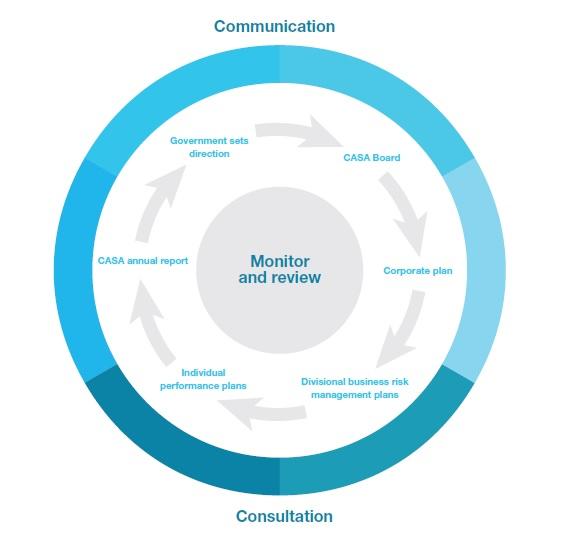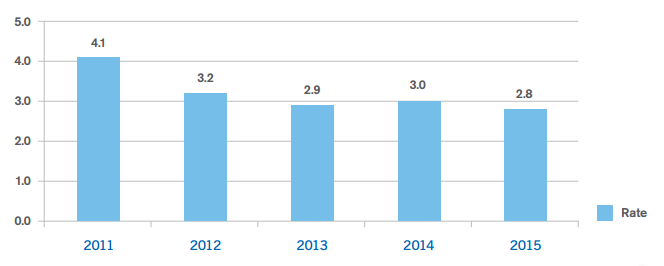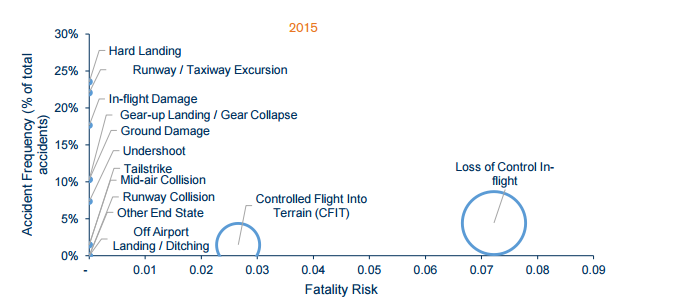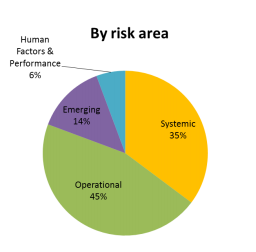The increased well-being of people combined with the high pace of globalization has resulted in great demand for air transport around the world. Additionally, statistics show that air transport is one of the safest kinds of transport (Dunn 2017). The combination of these facts has contributed to the emergence of the great demand for aircraft. However, this increased demand has also introduced another significant problem related to the organization of air transportation and the standards for passenger safety.
The fact is that heavy passenger flow can be a serious problem for an airport and its staff. Furthermore, with a current international situation that is characterized by tense relations as a result of terrorist threats and anti-terror wars, airports have become a primary target for terrorists because they play an important role in the functioning of a state, its infrastructure, its population, and more. Moreover, there are always many representatives of different states present there, a fact that could be exploited to attract attention and draw a response across global society.
Finally, there are numerous engineering challenges unique to aircraft and airports that may result in accidents. The combination of these facts has led to a reconsideration of the current approach to air transportation management and strategy. The alterations are so significant that they call for a comprehensive investigation to further the understanding of modern trends in air transport, as well as for the development of a strategic plan to improve aviation safety in a certain organization.
Background
As stated above, the number of threats to airports and aircraft has increased dramatically. At any moment, there could emerge numerous problems that might deteriorate the operations of any airport and pose a great threat to passenger safety. Additionally, there have been significant shifts in people’s mentality that have resulted in the appearance of high demands regarding the quality of air travel services.
That is why airports and staff face an array of complex problems that must be solved to improve the functioning of these organizations and guarantee that all passengers will be satisfied with the quality of service. In this regard, great attention is given to strategic planning and airport management to outline the most problematic areas and consider which approach would be most effective (Rodriguez & Cusick 2011). Furthermore, the rise of technology has introduced new tools, hardware, and software that could be explored to reorganize the functioning of an airport and introduce new and more secure systems that will help ensure passenger safety.
Objectives
The main aim of this paper is to investigate the existing strategic approach to airport management to determine its weak and strong points, improve the general comprehension of the given sphere and outline the most important concerns which may arise from the alteration of the environment. The usage of the Australian Corporate Plan related to aviation safety and security could also contribute to the reconsideration of the existing approach to airport operations and help outline the spheres of change that should be embraced.
Moreover, the above-mentioned process has resulted in the appearance of many different methods to manage the functioning of an airport, the credibility, and efficiency of which are questionable. For this reason, the current analysis is necessary to trace these alterations and determine the feasibility of the suggested strategies. Finally, the usage of an existing strategic plan as the background for the research increases the credibility of the findings and contributes to a better and more well-rounded investigation of the issue.
Investigation of the Australian approach
In investigating the Australian approach to the organization of the functioning of a certain airport, there are several important factors to take into consideration. First of all, according to statistics, the level of safety in Australian airports is high (Caldwell 2012). Indeed, the state has a low number of accidents that result in aircraft damage, passenger injuries, expenses, problems with civil order, and more, which should be considered good evidence of the overall efficiency of the country’s strategic approach (Ferguson & Nelson 2013). Additionally, because the Australian government has great expectations related to Civil Aviation Safety Authority (CASA) 2015 and the following several years, a strategic plan related to the further improvement of aviation safety and security becomes necessary to trace the most important alterations and evaluate their effectiveness. That is why the current Australian strategic position related to aviation safety and security could be described as well-thought-out and comprehensive. It creates a basis for further development and ensures safety for all passengers.
Determination of its Efficiency
At the moment, CASA is the main regulator of aviation security in Australia. It acts by the Public Governance, Performance, and Accountability (PGPA) Act 2013. The main aim of this act is to create the background for the efficient functioning of the airline industry by establishing a regulatory framework for maintaining, enhancing, and promoting safety in civil aviation (Civil Aviation Safety Authority 2015). Additionally, considering today’s complex international situation and the tension in international relations combined with the global threat of terrorism, this act also focuses on the prevention of aviation accidents and incidents by gradually increasing safety measures and implementing new technologies. When analyzing the given purposes, it becomes clear that the act’s attempt to incorporate all significant aspects of air security and create a unified approach to regulate these aspects should be considered an efficient system that contributes to several improved outcomes.
Investigation of Other Approaches
Compared to the plans of other nations, the Australian approach can be considered unique. Although other states have their strategic plans related to airport operations and aviation security management, CASA tends to implement the most innovative approaches that help the sphere evolve overall. In other Western states, the approach to airport management and security differs. In each state, there are of course regulatory agencies and authorities that investigate the performance of the given sphere and suggest their recommendations related to its further development (Rankin 2010).
However, they sometimes lack the required governmental support (Krause 2003) or suffer from the absence of a unified approach to the collection of data and the integration of the most efficient measures to guarantee the improvement of aviation safety and security (Rierson 2013). For this reason, it is clear that at the moment, there is no single approach shared among all states, as they all have their agencies aimed at creating and implementing the most efficient security measures that are needed to guarantee safety to passengers and avoid any accidents.
The decentralized approach could be considered both an advantage and a disadvantage of the whole aviation industry.The absence of a centralized plan complicates cooperation between different states, even though there is an international code that must be followed by all agencies to avoid accidents (Caldwell 2012). Without a centralized structure or system in place, terrorists or other people with malevolent motives might get the opportunity to explore some weaknesses and introduce threats to airport and passenger safety.
However, the diversity of the existing approaches may also be viewed positively, as it contributes to the discovery of new and more efficient measures to prevent organizations or individuals from harming, resulting in an increased level of security worldwide (Cromie et al. 2015). Whether primarily good or bad, there is at the moment no centralized concept used by the majority of states around the world.
Determination of the Main Aspects of any Strategic Approach
To be effective, a strategic approach to aviation safety and security should incorporate several important aspects to guarantee a high level of security. First, the approach should be universal and touch upon a great variety of aspects unique to the aviation industry. Additionally, it should rest on credible data and provide reliable results that could be explored in further research. Moreover, all of the meaningful aspects and departments of an airport—such as its physical areas, aircraft, workers, and more—should be covered by the strategic approach related to security, management, and strategy.
One should realize that it is impossible to foresee all security-related situations. However, the approach should provide a universal plan of action that could be used in case of an emergency. Finally, the financial aspect of airport management should also be considered to calculate possible spending and create a plan for change by the available funds. Only when all of these aspects are incorporated within a single document can it be considered effective enough to protect passengers.
Key Points
When analyzing Australia’s safety performance review of aviation in 2015-16, it is clear that all of the above-mentioned crucial points are taken into account in the given document and that it manages to introduce clear and distinctive purposes and outline the most important areas of change. Moreover, the performance review covers such important spheres as finance, management, and security, and it provides a clear description of actions performed to increase the efficiency of the most important processes and guarantee a positive final result. Additionally, it emphasizes CASA’s leading role in the preservation of aviation security and the assurance of passengers that their basic needs for transportation and other services will be fulfilled. With this in mind, the report incorporates the most crucial areas and demonstrates the necessity of the implementation of technologies that will help improve the airport’s environment by guaranteeing outstanding services to people and protecting them from any potential threat.
Current Strategic Position
The current strategic position regarding aviation safety in Australia implies the constant improvement of safety measures through the implementation of technologies and the reconsideration of outdated approaches (Civil Aviation Safety Authority 2015). Additionally, CASA aims at providing a fair, effective, and efficient aviation safety regulatory system along with an improvement of the safety culture with help from the aviation community as well as technologies, strategic approaches, and so on (Civil Aviation Safety Authority 2015). The current strategic position is also focused on the cultivation of excellence; courage to face and overcome new challenges; teamwork to promote the improvement of safety and security together; fairness to satisfy all clients; integrity to combine the most efficient approaches; and respect to improve the positive image of the organization and cooperate with passengers (Civil Aviation Safety Authority 2015). Additionally, CASA has introduced specific planning and reporting cycle that can be seen in the figure below (see Fig. 1 CASA’s planning and reporting cycle).

This figure shows that several basic elements should be considered when creating or updating a strategic approach and that these elements are interconnected. First, the CASA board introduces a corporate plan for the development of the approach to airport security and management. During the exploration phase, the given plan is also investigated to assess risk factors and collect data related to the individual performance of workers.
The collected information is then processed and included in the CASA annual report, which is shown to government officials and demonstrates the areas that still should be altered to increase the efficiency of aviation safety and security. In its turn, the government sets the direction for further development of the plan, and CASA responds by creating a new plan. The given cycle introduces the basis for the efficient functioning of the whole system and contributes to greatly improved outcomes as all elements are considered by multiple parties and can contribute to the development of a precise and strategic approach.
Main Issues and Challenges
Despite the existence of a clear strategic plan as described above, at the moment, the global aviation industry faces numerous challenges resulting from the rapid rise of technology, the evolution of traditional approaches, and the complexity of modern international relations. Australia is not an exception, and there are specific challenges unique to CASA. In this regard, the given report provides a list of the most relevant problems and suggests ways to solve them. For instance, aging aircraft is one of the major factors that can undermine passenger safety (Snyder & Ullrich 2017).
Numerous research studies have shown a direct correlation between the age of a plane and the probability of an accident (Wood 2003). The fact is that every vehicle has its own recommended lifetime that should not be exceeded to guarantee safety to its passengers. Understanding the great threat posed by aging aircraft, CASA has introduced an updated aging aircraft risk assessment tool that should be used by the Australian aviation industry to overcome this challenge.
In addition to aging aircraft, competition for safety-critical personnel should also be considered one of the important challenges arising from alterations of the environment and increased demands on airport management. For this reason, CASA encourages the recruitment of international specialists who will be able to share their experience and competence with local workers and improve the airport’s overall functioning. Finally, there is another critical challenge that comes from the complexity of modern international relations and increases the threat of terrorism in airports and aircraft. Airports must implement new and more efficient technologies to prevent terrorist acts and create a safe environment for all passengers. The complex character of these challenges explains the importance of constant improvements to airport management; to make these necessary changes, strategic plans of this sort become crucial.
Strong and Weak Points
Although CASA’s plan is well rounded, it does have both strong and weak aspects that should be taken into account. First of all, the large operating environment of the Australian aviation industry—which incorporates about 100,000 people across numerous facilities in different regions—could be considered one of the major advantages (Civil Aviation Safety Authority 2015). Moreover, another obvious strength of the Australian aviation industry is its focus on gradual improvement of the most crucial spheres and its deep understanding of the necessity of change to guarantee the highest levels of efficiency for many different processes. Indeed, both the government and CASA use different approaches and measures to guarantee that the sphere evolves and continues its existence. However, several weak points should be considered. First of all, it is still a comparatively weak security system (National Safety Council 2007). Being separated from other continents, Australia does not often encounter terrorist attacks, a fact that introduces a certain vulnerability to the system as it might collapse in case some unpredicted threat were to appear. However, CASA engages in several different international aviation organizations such as the International Civil Aviation Organization (ICAO) and International Air Transport Association (IATA) to guarantee that the most up-to-date information about possible threats is acquired.
Strategic Plan and Challenges
Strategic planning is another important aspect of CASA’s report related to air transport management and strategy in Australia. By the existing development plan, the implementation of reform initiatives outlined by the Australian Airspace policy statement remains the main goal for the development of the sector over the next several years. CASA is trying to reorganize the functioning of the majority of airports to guarantee the increased efficiency of procedures and a high level of security. Furthermore, the achievement of aviation safety objectives by implementing new methods and cooperating with the ICAO is another long-term goal introduced by the agency. However, there also several important aspects that should be kept in mind. First of all, the improvement of the basic components of any system requires additional spending, which means that extra financing will be needed to carry out the plan (Stolzer & Goglia 2015). Moreover, increased international cooperation between CASA and other agencies might demand some background in international relations to improve mutual understanding and attain successful results. However, despite the obvious complexity of these tasks, CASA continues the policy of gradually improving Australian airports’ functioning, a fact that is reflected in the given report.
ICAO
As stated above, cooperation with the ICAO is one of the most important concerns related to the functioning of any airport. The ICAO is an international organization that investigates the operations of airports and agencies all over the world to create the constantly improved environment necessary to guarantee safety to passengers and increase the overall effectiveness of aircraft travel (Yeh et al. 2012). For these reasons, ICAO’s recommendations should be considered a crucial element of international cooperation. Indeed, according to statistics (see Fig. 2 Global Accident Rates (per million departures)), the number of aircraft accidents has decreased in the last several years. This positive achievement has been reached due to the efficient functioning of the ICAO, along with its annual reports that provide basic safety recommendations and outline strategies for the improvement of airport operations and security.

In analyzing the ICAO recommendations, it becomes clear that they are explored and utilized by CASA to guarantee the significant improvement of the functioning of Australian airports and tend to implement the model characterized by increased security. ICAO’s main recommendations include aspects such as a focus on the state of the aircraft, worker competence, and security measures. Considering the positive statistics demonstrated by Fig. 2, the great efficiency of these measures and their positive impact on the state of the aviation industry in different regions is obvious.
IATA
In addition to the ICAO, the IATA also introduces specific regulations aimed at the improvement of global aviation security. The organization suggests its recommendations to airport management and monitors airports’ adherence to the basic security measures. Similar to those of the ICAO, statistics from the IATA incorporated in a graph (see Fig. 3 below) reveal that the aircraft accident frequency has become much lower in recent years. In addition to hard numbers, the IATA graph also demonstrates the main causes of aircraft accidents, of which hard landing or in-flight damage is the most common. This means that the suggested measures turn out to be effective as few crashes are caused as a result of airport management. Overall, the IATA and ICAO offer similar approaches to aviation safety and security that are closely interconnected. This similarity comes from the universal character of the given measures and the similarities between threats.

EASA
The European Aviation Safety Agency (EASA) also strives to improve airport management by suggesting a set of rules and regulations needed to protect passengers and improve security measures. This organization indicates the basic risk areas (see Fig. 4) which are operational, systemic, engineering, and human-related and provides a comprehensive plan aimed at the mitigation of the possible negative impact and the introduction of new security measures that could help attain significant improvements to safety. For this reason, the approach to airport management should be reconsidered for these organizations to be able to meet modern challenges and guarantee security to passengers. The organization points to the unique need for new technologies combined with additional training and professional growth (European Aviation Safety Agency 2014).

Best Practices
Altogether, different international and domestic organizations like the IATA, ICAO, EASA, and CASA devote great attention to the organization of security in airports and the creation of a safe environment for passengers to feel protected. The recommendations across these distinct organizations are similar and have several common points which are today considered best practices in air transportation security: the constant monitoring of the state of aircraft, additional training so that staff can act under complex conditions and make appropriate decisions, the analysis of the main causes of accidents to decrease their probability and so on. The exploration of these measures is considered one of the most efficient ways to attain success and reorganize airport operations by new demands (Stolzer, Halford & Goglia 2013).
Conclusion
In conclusion, the modern world has introduced numerous challenges for airport managers. The rise of technology, an increasingly complex international situation, and other significant factors have contributed to the necessity to reorganize the traditional approach to the provision of security and introduce new and efficient security measures in airports and aircraft (Roberts 2011). That is why aviation agencies like the IATA, ICAO, EASA, and CASA aim to improve international cooperation and create a unified approach that will increase the level of safety and help passengers feel safe.
Reference List
Caldwell, J 2012, ‘Crew schedules, sleep deprivation, and aviation performance’, Current Directions in Psychological Science, vol. 21, no. 2, pp. 85-89, Web.
Civil Aviation Safety Authority 2015, Corporate plan 2015-16 to 2018-19, Web.
Cromie, S, Ross, D, Corrigan, S, Liston, P, Darragh, L, & Demosthenous, E 2015, ‘Integrating human factors training into safety management and risk management: A case study from aviation maintenance’, Proceedings of the Institution of Mechanical Engineers, Part O: Journal of Risk and Reliability, vol. 229, no. 3, pp. 266-274, Web.
Dunn, R 2017, Gear up, mishaps down: The evolution of naval aviation safety, 1950-2000, Naval Institute Press, Annapolis, MD.
European Aviation Safety Agency 2014, European aviation safety plan 2014-2017, Web.
Ferguson, M & Nelson, S 2013, Aviation safety: A balanced industry approach, Delmar Cengage Learning, Clifton Part, NY.
IATA 2016, Safety report 2015, Web.
ICAO 2016, Safety report, Web.
Krause, S 2003, Aircraft Safety : Accident investigations, analyses, & applications, McGraw-Hill Education, New York, NY.
National Safety Council 2007, Aviation ground operation safety handbook, National Safety Council, Phyllis, KY.
Rankin, W 2010, ‘General aviation security: A safety management system model for collegiate learning’, Journal of Aviation/Aerospace Education & Research, vol. 19, no. 2, pp. 35-44, Web.
Rierson, L 2013, Developing safety-critical software: A practical guide for aviation software and DO-178C Compliance, CRC Press, Boca Raton, FL.
Roberts, M 2011, ‘Airport and aviation security: U.S. policy and strategy in the age of global terrorism’, Journal of Strategic Security, vol. 4, no. 2, pp. 125-127, Web.
Rodriguez, C & Cusick, S 2011, Commercial aviation safety, 5th Edition, McGraw-Hill Education, New York, NY.
Snyder, P & Ullrich, G 2017, Practical safety management systems: A practical guide to transform your safety program into a functioning safety management system, Aviation Supplies and Academics, Inc, Newcastle, WA.
Stolzer, A & Goglia, J 2015, Safety management systems in aviation, Routledge, London.
Stolzer, A, Halford, C, Goglia, J 2013, Implementing safety management systems in aviation (Ashgate Studies in Human Factors for Flight Operations), Routledge, London.
Wood, R 2003, Aviation safety programs: A management handbook, Jeppesen Sanderson, Inverness, CO.
Yeh, M, Swider, C, Abbott, K, Donovan, C, Neiderman, E & Piccione, D 2012, ‘Human factors at the federal aviation administration (FAA): From research to reality’, Proceedings of the Human Factors and Ergonomics Society Annual Meeting, vol, 56, no. 1, pp. 56-60, Web.